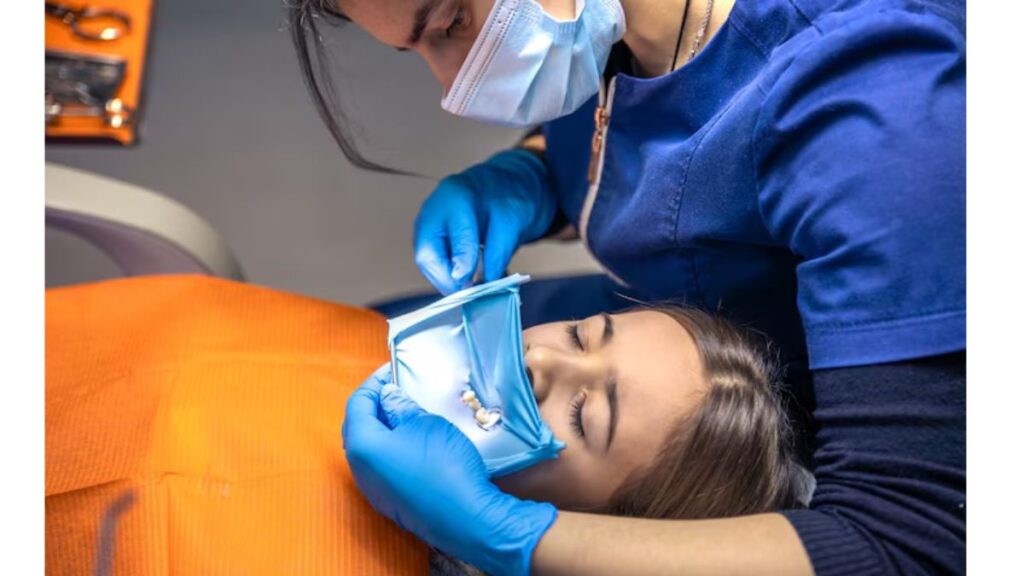Good oral health is important for a happy and healthy life. While brushing, flossing, and regular checkups are key, sometimes a tooth must be removed to protect your smile. This is where tooth extraction services come in. Tooth extractions might sound scary, but they are a common and safe dental procedure.Dentists and oral surgeons perform extractions every day to treat problems like tooth decay, infections, and overcrowding. Removing a bad tooth can help prevent pain and protect the rest of your teeth.
What Is a Tooth Extraction?
A tooth extraction is a common dental procedure where a tooth is removed from its socket in the gum and jawbone. Dentists or oral surgeons usually perform this when a tooth is too damaged or infected to be saved with a filling or crown. It may also be done if a tooth is causing crowding, pain, or problems with alignment.
There are two main types of extractions:
Simple Extractions
These are used when the tooth is fully visible and easy to remove. The dentist uses tools to loosen the tooth and gently pull it out. This procedure is usually quick and done in one visit.
Surgical Extractions
These are needed when a tooth is broken at the gum line or impacted (like many wisdom teeth). The oral surgeon may need to cut the gum or remove some bone to access the tooth. This is a more complex process but is still done safely with local anesthesia.
In both cases, numbing medicine is used so you don’t feel pain during the procedure. You might feel some pressure, but the goal is to keep you as comfortable as possible.
Reasons for Tooth Extraction
Tooth extraction is usually the last resort. Dentists try to save teeth when possible. But sometimes, removing a tooth is the best way to protect your oral health. Here are the main reasons why a tooth may need to be pulled:
Severe Tooth Decay
When a tooth has too much decay, it may be beyond repair. Cavities that reach deep into the tooth can cause infection and pain. If the damage cannot be fixed with a filling or crown, the tooth may need to be removed. Taking it out stops the decay from harming other teeth and your gums.
Tooth Infection
An infected tooth can cause swelling, pain, and even fever. Infections happen when bacteria enter the tooth through a deep cavity or crack. If a root canal cannot treat the infection, removing the tooth may be the best option. This helps stop the infection from spreading to other parts of your body.
Overcrowding
Overcrowding happens when there isn’t enough space in your mouth for all your teeth. This can lead to crooked teeth and bite problems. Removing one or more teeth can create the room needed for proper alignment. Dentists often suggest this before orthodontic treatments like braces.
Impacted Wisdom Teeth
Wisdom teeth are the last molars to grow, usually in the late teens or early twenties. They often become impacted, meaning they are stuck under the gums or grow at the wrong angle. This can cause pain, swelling, and damage to nearby teeth. In these cases, an appointment with an oral surgeon is needed to remove them safely.
Gum Disease
Advanced gum disease, or periodontitis, weakens the bone and tissue that support your teeth. When this happens, teeth can become loose or shift out of place. In some cases, it’s better to remove the tooth to stop further damage. This also helps protect the remaining healthy teeth and gums.
What to Expect During a Tooth Extraction
Knowing what happens during a tooth extraction can help you feel calm and prepared.
Step 1: Exam and X-rays
Your dentist will first examine your mouth and take X-rays of the affected tooth. These images show the tooth’s position and help plan the best way to remove it. The dentist will also review your medical history. This ensures the procedure is safe and goes smoothly.
Step 2: Numbing the Area
Before the extraction, the dentist will use local anesthesia to numb the area. This prevents pain during the procedure. If it’s a surgical extraction or you’re very nervous, you may also get sedation to help you stay calm. The goal is to make the process as comfortable as possible.
Step 3: Removing the Tooth
For a simple extraction, the dentist uses a tool to gently loosen the tooth and lift it out. If the tooth is broken or under the gum, surgery may be needed to reach it. The dentist or oral surgeon might cut the gum or remove a bit of bone. Each step is done with care to avoid harming nearby tissues.
Step 4: Closing the Site
Once the tooth is removed, the area may be stitched to help it heal. The dentist will place a piece of gauze over the spot and ask you to bite down. This helps stop the bleeding and form a blood clot. You’ll also receive aftercare instructions to follow at home.
Aftercare: Healing and Recovery
Taking care of your mouth after a tooth extraction is important. It helps prevent infection and makes sure you heal well.
What to Do After the Procedure
You should rest for the first 24 hours and avoid any hard activity. Keep the gauze in place to help the bleeding stop, and change it as needed. Use ice packs on your cheek for 10-20 minutes at a time to reduce swelling. Take all prescribed medicine, including pain relief, as directed by your dentist.
Foods to Eat
Soft foods are the best choice while you heal. Good options include yogurt, soup, mashed potatoes, and smoothies. These foods are gentle on your mouth and easy to eat. Try to eat slowly and avoid anything too hot or spicy.
What to Avoid
You should avoid smoking, drinking through a straw, and touching the extraction site. These actions can dislodge the blood clot and slow healing. Also, skip hard, crunchy, or sticky foods that might irritate the area. Follow your dentist’s instructions closely to ensure a smooth recovery.
Signs of a Healthy Recovery
Most people heal well within a week after a tooth extraction. Mild swelling and pain are normal and should get better each day. You should notice the bleeding stop within a few hours after the procedure. As long as the area is clean and free from pus, it means healing is going well.
What Is a Dry Socket?
A dry socket is a painful condition that can happen after a tooth extraction. It occurs when the blood clot that forms after removal is lost too early. This exposes the bone and nerves, causing severe pain. It’s more common with wisdom tooth removal but can happen with any extraction.
You may notice sharp pain a few days after the extraction, along with a bad smell or taste. The site may look dry, and you might see bone where the tooth was. If this happens, contact your dentist right away. They will clean the area and apply special medicine to help it heal.
Tooth Replacement Options After Extraction
After losing a tooth, you may want to replace it, especially if it affects your smile or how you chew. Here are common options:
Dental Implants
Dental implants are small metal posts placed in your jawbone. They act like the root of a missing tooth and hold a crown in place. Implants look natural and can last many years with proper care. They are a strong and popular choice for tooth replacement.
Bridges
A bridge is a fixed dental device that fills the space left by a missing tooth. It uses nearby teeth to hold the false tooth in place. Bridges help restore your bite and make chewing easier. They also keep other teeth from shifting into the gap.
Dentures
Dentures are removable devices that replace one or more missing teeth. They are made to fit your mouth and can be taken out for cleaning. Dentures are a cost-friendly option, especially if you are missing many teeth. Your dentist can help you decide if full or partial dentures are right for you.
Children and Tooth Extractions
Tooth extractions aren’t just for adults. Kids may need them, too, in certain situations:
Baby Teeth That Won’t Fall Out
Sometimes baby teeth don’t come out when they should. This can block adult teeth from growing properly. In these cases, the dentist may gently remove the baby’s tooth. This helps make room for the adult tooth to come in straight.
Severely Damaged or Decayed Teeth
If a child has a tooth that’s badly broken or decayed, it may need to be removed. This helps prevent infection and pain. Taking the tooth out also protects the surrounding teeth and gums. Dentists use gentle techniques to keep kids comfortable.
Orthodontic Reasons
Sometimes, teeth are removed before getting braces. This helps create space and ensures the teeth move into the right position. Pediatric dentists work closely with orthodontists to plan this treatment. Proper timing makes the process easier and more effective.
Wisdom Tooth Removal
Wisdom teeth can cause problems when there isn’t enough room in the mouth. They may grow sideways, become stuck under the gums, or cause infections. When this happens, removal is often the best option.
Your dentist will check your wisdom teeth with X-rays. If they’re impacted or causing pain, you’ll likely need an appointment with an oral surgeon. Removing them early before they cause damage is often the safest route.
Emergency Tooth Extractions
In some cases, a tooth must be removed right away. This is called an emergency extraction and is done to relieve severe pain or prevent serious problems.
When Is It an Emergency?
A cracked or broken tooth that can’t be fixed may need immediate removal. Infections that cause swelling, fever, or trouble swallowing are also emergencies. Accidents or sports injuries may also lead to urgent extractions.
What to Do
If you think you need an emergency extraction, call your dentist or an emergency dental clinic. Acting quickly helps avoid bigger problems. The goal is to stop pain and prevent the issue from getting worse.
Choosing the Right Dentist or Oral Surgeon
Choosing the right professional makes a big difference in your care. You want someone skilled, caring, and able to explain things clearly.
Here are some helpful tips to guide your decision:
- Check experience and qualifications
- Read reviews and ask for recommendations
- Schedule a consultation
- Evaluate the office environment
- Ask about sedation options
Taking the time to choose the right provider can make a big difference in how confident and comfortable you feel throughout the process.
Cost of Tooth Extractions
Tooth extraction costs vary depending on the type of procedure and your location. A simple extraction usually costs between $75 and $300. Surgical extractions, such as wisdom teeth removal, may cost $200 to $800 per tooth or more.
Many dental insurance plans cover part of the cost. Be sure to check with your provider and ask for a cost estimate. Some clinics also offer payment plans or discounts for cash payments.
Tooth extractions can play a key role in improving your overall oral health. While losing a tooth might seem like a negative thing at first, it’s often the best way to stop pain and prevent serious dental issues from getting worse.
If a tooth is badly decayed, infected, or broken beyond repair, removing it stops the damage from spreading to other areas of your mouth. This helps protect your gums, jawbone, and surrounding teeth.
An extraction can also help correct problems with spacing or alignment. If your teeth are crowded, removing one or more can create room for the others to move into the right position, which is especially helpful before getting braces. Extractions are also often necessary before fitting dentures or placing dental implants, ensuring that future treatments have a stable, healthy foundation.
Take the Next Step for Your Oral Health
Tooth extractions may sound scary, but they are often a necessary step toward better health. Whether it’s dealing with pain, fixing a crowded mouth, or removing wisdom teeth, extractions can make a big difference in your smile and comfort.
If you’re experiencing dental pain or have been told you need a tooth removed, don’t wait. Contact your local dentist today to schedule a consultation. Protect your oral health and start your journey toward a brighter, healthier smile!
If this article covered all your questions, why not stroll through our blog for more empowering and informative content?







